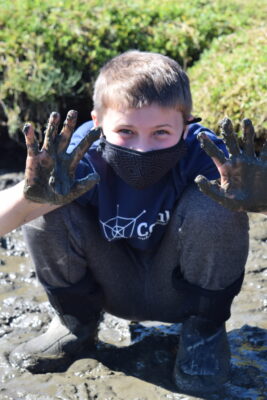For Logan, it was a dream come true. He was bursting at the seams with excitement when he talked about how he wanted to become a marine biologist. Now he had a chance to be face-to-face with a professional restoration ecologist from the Puget Sound Restoration Fund (PSRF).
On this sunny September morning, Logan got to explore the shorelines of the Klingel-Bryan-Beard Wildlife Refuge and Belfair State Park. He collected data on habitat conditions and participated in the ongoing efforts to figure out whether PSRF should try and restore the historic populations of Olympia oysters that once thrived in this corner of Hood Canal.

This was all possible thanks to Land Labs! Great Peninsula Conservancy partnered with the Puget Sound Restoration Fund to hold a Land Labs session and teach students about the world of Olympia oysters. This native species of oyster has found itself the victim of overcrowding and overharvesting over the course of the 20th century. Now it has all but vanished from Puget Sound. Instead, one finds the imported Pacific oyster on our shorelines and in our restaurants.
These two species can coexist. They tend to inhabit different shoreline elevations, so competition between them is not too fierce. But regional populations of Olympia oysters need a helping hand if they’re going to return. They play an important role in the ecosystem, filtering the water and creating habitat in their reefs. When eaten, Olympia oysters have a unique flavor.
In the end, the student scientists of Land Labs and our partners at PSRF decided that the Klingel-Bryan-Beard Wildlife Refuge was too high up on the shore and the muddy substrate too soft to be appropriate for Olympia oyster restoration. But they’re looking into other GPC sites on Hood Canal, and a good option may soon present itself.

Regardless, the benefits of learning outside are apparent. Parks and preserves provide open-air classrooms where face-to-face interaction is safe and easy. Students can get away from their screens, while learning about the environment by being out in it. When we take students outside, we can get them to see the world from a whole new perspective, and open their eyes to the possibilities of thinking like a restoration scientist. They can connect with each other, connect with nature, and connect with exciting STEM careers.
Some students, like Logan, showed up with a boatload of enthusiasm for STEM. But for some of the students this may have been their first invitation to be scientists. It may have been their first opportunity to explore a part of the Puget Sound’s shoreline, and to activate their natural curiosity. These are the students that Land Labs hopes to reach.
Sometimes, a student’s first step to a career in STEM happens when they are invited to see themselves as a scientist. These students from Catalyst Public School have now all participated in a real scientific study. Maybe one day, this kind of work will be part of their daily routine: pulling on some waders or a diving suit, taking measurements of the water’s temperature and salinity, and doing what they can to restore our ecosystems and keep them healthy.

